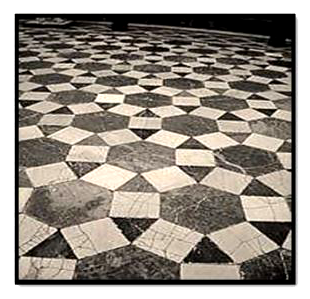A tiling or tessellation of a flat surface is the covering of a plane using one or more geometric shapes, called tiles, with no overlaps and no gaps. Historically, tessellations were used in ancient Rome and in Islamic art. You may find tessellation patterns on floors, walls, paintings etc. Shown below is a tiled floor in the archaeological Museum of Seville, made using squares, triangles and hexagons.

A craftsman thought of making a floor pattern after being inspired by the above design. To ensure accuracy in his work, he made the pattern on the Cartesian plane. He used regular octagons, squares and triangles for his floor tessellation pattern

Use the above figure to answer the questions that follow:
What is the area of Trapezium AFGH?
Step by step video & image solution for A tiling or tessellation of a flat surface is the covering of a plane using one or more geometric shapes, called tiles, with no overlaps and no gaps. Historically, tessellations were used in ancient Rome and in Islamic art. You may find tessellation patterns on floors, walls, paintings etc. Shown below is a tiled floor in the archaeological Museum of Seville, made using squares, triangles and hexagons. A craftsman thought of making a floor pattern after being inspired by the above design. To ensure accuracy in his work, he made the pattern on the Cartesian plane. He used regular octagons, squares and triangles for his floor tessellation pattern Use the above figure to answer the questions that follow: What is the area of Trapezium AFGH? by Maths experts to help you in doubts & scoring excellent marks in Class 10 exams.
Updated on:21/07/2023Topper's Solved these Questions
Similar Questions
Knowledge Check
Polymer used in marking floor tiles is
AteflonBpolypropyleneCpolyvinyl ChlorideDbuta-1, 3-dieneName the plastic which is used for making switch, floor and tiles.
AThermoplasticsBThermosettingCSynthetic plasticsDNone of the aboveTesselated epithelium can be traced in :
ABlood vesselsBMesotheliumCPeritoneumDAll of these
What is tesselated epithelium ? Where is it found?
View SolutionA room is 4.5 m long and 4 m wide. The floor of the room is to be covered with tiles of size 15 cm by 10 cm. Find the cost of covering the floor with tiles at the rate of Rs.4.50 per tile.
View SolutionSabina wants to cover the floor of her room whose length is 4 m and breadth is 3m by square tiles. If each square tile is of side 20cm. then find the number of tiles required to cover the floor of her room.
View SolutionSandra wants to get her kitchen floor tiled with square tiles such that each tile has a side of 2 ft. The kitchen is of 18 ft length and 16 ft width and each square tile has an area of 4 ft2. What is the area of the kitchen floor?
View Solution40*48 size of a room is about to be constructed and for the construction, builder has ordered the required square tiles for the room. Find the minimum number of square tiles required for the construction if the size of the tile is maximum?
View Solution

